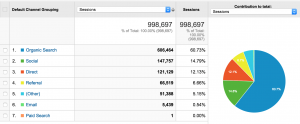 Analyzing your web traffic information can be an important tool for many different reasons. However, before you can utilize this tool, you need to understand the ways to interpret your information.
Analyzing your web traffic information can be an important tool for many different reasons. However, before you can utilize this tool, you need to understand the ways to interpret your information.
The majority web hosting companies will supply you with basic web traffic information that you need to interpret later and make significant use of it. On the other hand, the statistics you obtain from your host company can be overpowering if you have no idea about the ways to apply it to your business and website. Now, let’s begin by investigative the most basic data – the average visitors to your site on a daily, weekly, and monthly basis.
These figures are good because it is the most accurate measure of your website’s traffic. There is always a misunderstanding about the traffic you see recorded, you assume that your website is performing well, but sad to say, this is a mistaken perception. Besides the website’s traffic, you also need to look at the actions of your visitors once they come to your website in order to correctly determine the success of your site.
In addition, there is often a fallacy about what is normally known as “hits” and what is really useful, quality traffic to your website. Hits merely mean the number of information requests received by the server. If you know that the facts such as a hits can be the number of graphic on your page, you will see how exaggerated the idea of hits can be. For instance, if your homepage have 14 graphic on it, the server will records 14 hits, when we are actually talking about a single visitor visiting a single page on your site. So you must have understood now that “hits” are not useful in traffic analysis.
Remember the formula, more visitors = more accurate interpretation. Similarly, the larger the traffic is to your website, the more accurate your analysis will be in your visitor behaviour. On the other hand, a few irregular visitors can distort the analysis easily if your visitors are less.
The plan is to use the web traffic statistics to figure out the performances of your site. One example of doing this is to learn how the average time of your visitors spends on your site. If they rarely spend their time on your website, it usually means there is a problem on your website. Then, the real challenge is to discover the cause of the problem.
You could have directed wrong type of visitor to your website by wrong keywords, or that your graphics are confusing or frightening, causing the visitor to exit on their first sight. By knowing how much time visitors are spending on your site to identify specific problems. After you find the cause and fix it, continue to use time spent as a estimate of how effective your fix has been.
Additionally, web traffic stats can help you find out effective and ineffective parts of your website. If you have a page that you believe is important, but the visitors are exiting it quickly or not even visit it, that page needs serious attention. To solve the problem, you can try to improve the link by making it more noticeable or interesting. You could also improve the appearance of the page or ease your visitors to access the necessary information on that page. On the other hand, if you note that visitors are spending a lot of time on pages that you think are insignificant, you might consider moving some of your sales copy and marketing focus to that particular page for more exposure.
As you can see, these figures will reveal vital information about the effectiveness of individual pages, visitor behaviour and incentive. This is necessary information to any successful Internet marketing campaign.
Your website certainly has some exit pages, such as a contact form or final order. Well, this is the page that your visitor will exit quickly. However, not every visitor to your site is going to found exactly what they are searching, so statistics may show you several different exit pages. This is normal unless you notice an exit trend on a particular page that is not planned as an exit page. In this case, you must carefully inspect that particular page to distinguish the problem. Once you identify potential weaknesses on that page, some modifications in content or graphic are need and it may have a significant impact on the keeping visitors staying in your site instead of exiting at the wrong page.
After you have analyzed your visitor statistics, it’s time to turn to your keywords and phrases. Notice that a keyword is directing a specific type of visitor to your site. If your keywords are working well, the visitors will find what they are looking for on your site, and sometime even better, fill out your contact form or make a purchase.
However, if you discover a huge number of visitors are being misdirected – to your site by a specific keyword or phrase, that keyword needs to be change. Keywords are crucial to bringing quality visitors to your site who have the interest to do business with you. Close analysis of the keywords that your visitors are using to search your site will give you a very important understanding of your visitor’s desires and incentive.
Lastly, if your find out that your visitor actually goes to your site by enter your company name. You should be happy because you have achieved a considerable level of brand recognition, and this is a sure sign of growing success.
 WebsiteTrafficHitlistWebsite Traffic Hitlist
WebsiteTrafficHitlistWebsite Traffic Hitlist
 A few website flipping products I can recommend:
A few website flipping products I can recommend: Website flipping Blueprint profit
Website flipping Blueprint profit Buying and selling, in the form of real estate properties or other valuables is considered as a very profitable activity. Just take the case of the more successful real estate agents in town.By simply buying plain looking homes and properties, tweaking and updating it and selling it at a higher price, they actually earn a significant amount of money.
Buying and selling, in the form of real estate properties or other valuables is considered as a very profitable activity. Just take the case of the more successful real estate agents in town.By simply buying plain looking homes and properties, tweaking and updating it and selling it at a higher price, they actually earn a significant amount of money. Analyzing your web traffic information can be an important tool for many different reasons. However, before you can utilize this tool, you need to understand the ways to interpret your information.
Analyzing your web traffic information can be an important tool for many different reasons. However, before you can utilize this tool, you need to understand the ways to interpret your information.